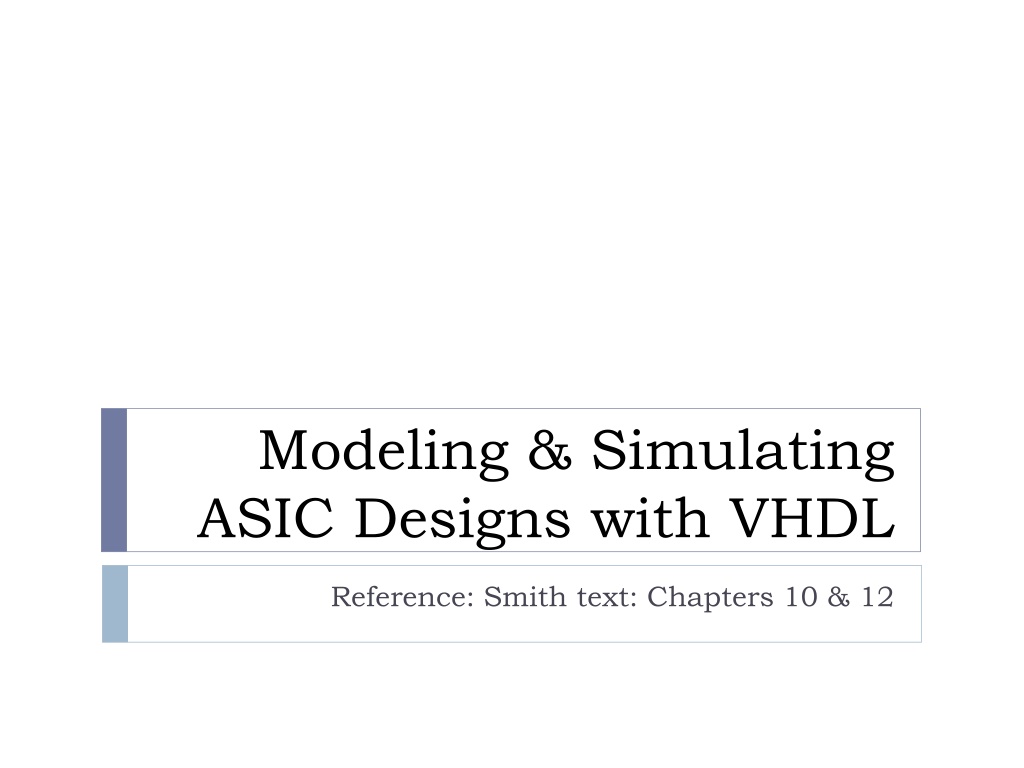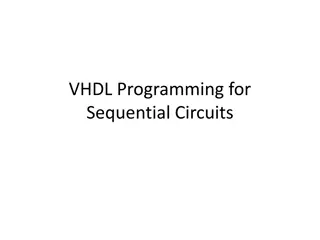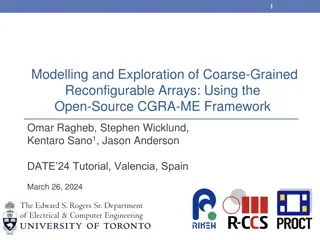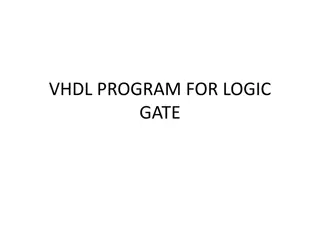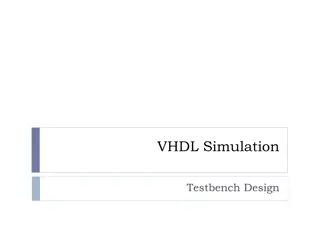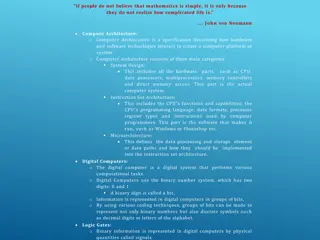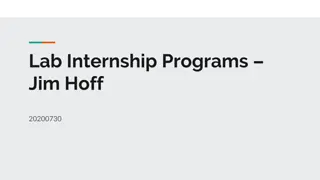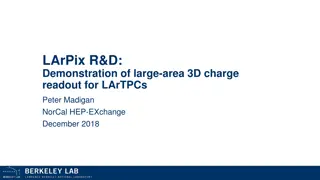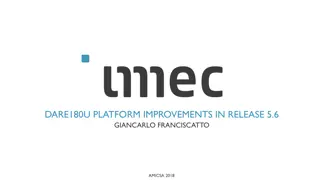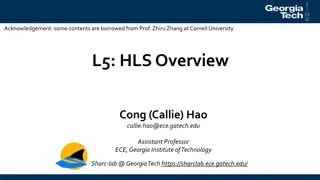Understanding VHDL for ASIC Design: A Comprehensive Guide
Explore the world of VHDL for ASIC designs, covering topics such as modeling, simulation, HDLs in digital system design, anatomy of a VHDL model, port identifier modes, and data types. Learn how to define entities and architectures, declare I/O ports, handle signal directions, and understand naming rules for identifiers. Dive into the nuances of different modes like in, out, inout, and buffer, and gain insights into creating efficient and effective designs through automated synthesis and simulation techniques.
Uploaded on Sep 21, 2024 | 0 Views
Download Presentation

Please find below an Image/Link to download the presentation.
The content on the website is provided AS IS for your information and personal use only. It may not be sold, licensed, or shared on other websites without obtaining consent from the author. Download presentation by click this link. If you encounter any issues during the download, it is possible that the publisher has removed the file from their server.
E N D
Presentation Transcript
Modeling & Simulating ASIC Designs with VHDL Reference: Smith text: Chapters 10 & 12
HDLs in Digital System Design Model and document digital systems Hierarchical models System, RTL (Register Transfer Level), Gates Different levels of abstraction Behavior, structure Verify circuit/system design via simulation Automated synthesis of circuits from HDL models using a technology library output is primitive cell-level netlist (gates, flip flops, etc.)
Anatomy of a VHDL model Entity describes the external view of a component Architecture describes the internal behavior and/or structure of the component Example: 1-bit full adder Full Adder A Sum B Cout Cin
Example: 1-Bit Full Adder entity full_add1 is port ( a: in bit; b: in bit; cin: in bit; sum: out bit; cout: out bit); -- carry output end full_add1 ; -- I/O ports -- addend input -- augend input -- carry input -- sum output I/O Port Declarations Comments follow double-dash Type of signal Signal name Signal direction (mode)
Port: Identifier: Mode Data_type; Identifier (naming) rules: Can consist of alphabet characters (a-z), numbers (0-9), and underscore (_) First character must be a letter (a-z) Last character cannot be an underscore Consecutive underscores are not allowed Upper and lower case are equivalent (case insensitive) VHDL keywords cannot be used as identifiers 1 of 3
Port: Identifier: Mode Data_type; Mode in - driven into the entity from an external source (can read, but not update within architecture) out - driven from within the entity (can drive but not read within architecture) inout bidirectional; drivers both within the entity and external (can read or write within architecture) buffer like out but can read and write 2 of 3
Port: Identifier: Mode Data_type; Data_type: = scalar or aggregate signal type Scalar (single-value) signal types: bit values are 0 or 1 std_logic same as bit, but for standard simulation/synthesis (IEEE standard 1164) integer - values [-231 +(231-1)] on 32-bit host Aggregate (multi-value) signal types: bit_vector array of bits std_logic_vector array of std_logic (IEEE 1164) All vectors must have a range specified: Ex. bit_vector(3 downto 0) or std_logic_vector(0 to 3) 3 of 3
IEEE std_logic_1164 package -- For simulation and synthesis, std_logic preferred over bit. -- Provides additional logic states as data values type STD_LOGIC is ( 'U', -- Uninitialized 'X', -- Forcing Unknown '0', -- Forcing 0 '1', -- Forcing 1 'Z', -- High Impedance 'W', -- Weak Unknown 'L', -- Weak 0 'H', -- Weak 1 '-' -- Don't Care); You must include the library and package declarations in the VHDL model before the entity. (Example on next slide)
Example: 8-bit full adder -- Adder with 8-bit inputs/outputs library ieee; --supplied library use ieee.std_logic_1164.all; --package of definitions entity full_add8 is port ( a: in std_logic_vector(7 downto 0); b: in std_logic_vector(7 downto 0); cin: in std_logic; sum: out std_logic _vector(7 downto 0); cout: out std_logic); end full_add8 ;
Format for Architecture body architecture architecture_name of entity_name is -- data type definitions (ie, states, arrays, etc.) -- internal signal declarations signal signal_name: signal_type; : signal signal_name: signal_type; -- component declarations see format below -- function and procedure declarations begin -- behavior of the model is described here and consists of concurrent interconnecting: -- component instantiations -- processes -- concurrent statements including: Signal Assignment statements When-Else statements With-Select-When statements end architecture architecture_name; Note: entity and architecture in the end statement is optional.
Architecture defines function/structure -- behavioral model (no circuit structure implied) architecture dataflow of full_add1 is signal x1: std_logic; -- internal signal begin x1 <= a xor b after 1 ns; sum <= x1 xor cin after 1 ns; cout <= (a and b) or (a and cin) or (b and cin) after 1 ns; end;
Structural architecture example (no behavior specified) architecture structure of full_add1 is component xor port (x,y: in bit; z: out bit); end component; for all: xor use entity work.xor(eqns); -- if multiple arch s signal x1: bit; -- signal internal to this component begin G1: xor port map (a, b, x1); -- instantiate 1st xor gate G2: xor port map (x1, cin, sum); -- instantiate 2nd xor gate add circuit for carry output end; -- declare component to be used
Associating signals with formal ports component AndGate port (Ain_1, Ain_2 : in BIT; -- formal parameters Aout : out BIT); end component; -- positional association: A1:AndGate port map (X, Y, Z1); -- named association: A2:AndGate port map (Ain_2=>Y, Aout=>Z2, Ain_1=>X); -- both (positional must begin from leftmost formal): A3:AndGate port map (X, Aout => Z3, Ain_2 => Y);
Example: D flip-flop entity DFF is port (Preset: in bit; Clear: in bit; Clock: in bit; Data: in bit; Q: out bit; Qbar: out bit); end DFF; Preset Data Q Clock Qbar Clear
7474 D flip-flop equations architecture eqns of DFF is signal A,B,C,D: bit; signal QInt, QBarInt: bit; begin A <= not (Preset and D and B) after 1 ns; B <= not (A and Clear and Clock) after 1 ns; C <= not (B and Clock and D) after 1 ns; D <= not (C and Clear and Data) after 1 ns; Qint <= not (Preset and B and QbarInt) after 1 ns; QBarInt <= not (QInt and Clear and C) after 1 ns; Q <= QInt; -- Can drive but not read outs QBar <= QBarInt; -- Can read & drive internals end;
4-bit Register (Structural Model) entity Register4 is port ( D: in bit_vector(0 to 3); Q: out bit_vector(0 to 3); Clk: in bit; Clr: in bit; Pre: in bit); end Register4; D(3) D(2) D(1) D(0) CLK PRE CLR Q(0) Q(1) Q(2) Q(3)
Register Structure architecture structure of Register4 is component DFF port (Preset: in bit; Clear: in bit; Clock: in bit; Data: in bit; Q: out bit; Qbar: out bit); end component; signal Qbar: bit_vector(0 to 3); -- dummy for unused FF outputs begin -- Signals connect to ports in order listed above F3: DFF port map (Pre, Clr, Clk, D(3), Q(3), Qbar(3)); F2: DFF port map (Pre, Clr, Clk, D(2), Q(2), Qbar(2)); F1: DFF port map (Pre, Clr, Clk, D(1), Q(1), Qbar(1)); F0: DFF port map (Pre, Clr, Clk, D(0), Q(0), Qbar(0)); end; -- declare library component to be used
Conditional Signal Assignment signal a,b,c,d,y: std_logic; signal S: std_logic_vector(0 to 1); begin with S select y <= a after 1 ns when 00 , b after 1 ns when 01 , c after 1 ns when 10 , d after 1 ns when 11 ; --Alternative default : d after 1 ns when others; 4-to-1 Mux 00 a 01 b y 10 c 11 d S
32-bit-wide 4-to-1 multiplexer signal a,b,c,d,y: bit_vector(0 to 31); signal S: bit_vector(0 to 1); begin with S select y <= a after 1 ns when 00 , b after 1 ns when 01 , c after 1 ns when 10 , d after 1 ns when 11 ; --a,b,c,d,y can be any type, as long as they are the same 4-to-1 Mux 00 a 01 b y 10 c 11 d S
Conditional Signal Assignment Alternate Format y <= a after 1 ns when (S= 00 ) else b after 1 ns when (S= 01 ) else c after 1 ns when (S= 10 ) else d after 1 ns; 4-to-1 Mux 00 a 01 b y 10 c 11 d Use any boolean expression for each condition: y <= a after 1 ns when (F= 1 ) and (G= 0 ) S
VHDL Process Construct [label:] process (sensitivity list) declarations begin sequential statements end process; Process statements executed once at start of simulation Process halts at end until an event occurs on a signal in the sensitivity list Allows conventional programming language methods to describe circuit behavior
Modeling sequential behavior -- Edge-triggered flip flop/register entity DFF is port (D,CLK: in bit; Q: out bit); end DFF; architecture behave of DFF is begin process(clk) -- process sensitivity list begin if (clk event and clk= 1 ) then Q <= D after 1 ns; end if; end process; end; D Q CLK Process statements executed sequentially (sequential statements) clk event is an attribute of signal clk which is TRUE if an event has occurred on clk at the current simulation time
Edge-triggered flip-flop Alternative methods for specifying clock process (clk) begin if rising_edge(clk) then -- std_logic_1164 function Q <= D ; end if; end process; Leonardo also recognizes not clk stable as equivalent to clk event
Alternative to sensitivity list process -- no sensitivity list begin wait on clk; -- suspend process until event on clk if (clk= 1 ) then Q <= D after 1 ns; end if; end process; D Q CLK Other wait formats: wait until (clk event and clk= 1 ) wait for 20 ns; This format does not allow for asynchronous controls Process executes endlessly if no sensitivity list or wait statement!
Level-Sensitive D latch vs. D flip-flop entity Dlatch is port (D,CLK: in bit; Q: out bit); end Dlatch; architecture behave of Dlatch is begin process(D, clk) begin if (clk= 1 ) then Q <= D after 1 ns; end if; end process; end; D Q CLK Latch, Q changes whenever the latch is enabled by CLK= 1 (rather than edge-triggered)
Defining a register for an RTL model (not gate-level) entity Reg8 is port (D: in bit_vector(0 to 7); Q: out bit_vector(0 to 7); LD: in bit); end Reg8; architecture behave of Reg8 is begin process(LD) begin if (LD eventand LD= 1 ) then Q <= D after 1 ns; end if; end process; end; D and Q could be any abstract data type D(0 to 7) LD Reg8 Q(0 to 7)
Basic format for synchronous and asynchronous inputs process (clock, asynchronously_used_signals ) begin if (boolean_expression) then asynchronous signal_assignments elsif (boolean_expression) then asynchronous signal assignments elsif (clock event and clock = contstant) then synchronous signal_assignments end if ; end process;
Synchronous vs. Asynchronous Flip-Flop Inputs entity DFF is port (D,CLK: in bit; PRE,CLR: in bit; Q: out bit); end DFF; architecture behave of DFF is begin process(clk,PRE,CLR) begin if (CLR= 0 ) then -- async CLR has precedence Q <= 0 after 1 ns; elsif (PRE= 0 ) then -- then async PRE has precedence Q <= 1 after 1 ns; elsif (clk event and clk= 1 ) then Q <= D after 1 ns; -- sync operation only if CLR=PRE= 1 end if; end process; end; CLR D Q CLK PRE
Modeling Finite State Machines (Synchronous Sequential Circuits) FSM design & synthesis process: Design state diagram (behavior) Derive state table Reduce state table Choose a state assignment Derive output equations Derive flip-flop excitation equations Synthesis steps 2-6 can be automated, given the state diagram 1. 2. 3. 4. 5. 6.
Synchronous Sequential Circuit Model Inputs x Outputs z Comb. Logic Present State y Next State Y FFs Clock Mealy Outputs z = f(x,y), Moore Outputs z = f(y) Next State Y = f(x,y)
Synchronous Sequential Circuit (FSM) Example 0/0 Input x Present state A B C X/Z 0 1 A A/0 A/0 C/0 B/0 C/1 A/1 1/1 1/0 0/0 0/0 Next state/output B C 1/1
FSM Example entity definition entity seqckt is port ( end seqckt; x: in bit; z: out bit; clk: in bit ); -- clock -- FSM input -- FSM output
FSM Example - behavioral model architecture behave of seqckt is type states is (A,B,C); -- symbolic state names (enumerate) signal curr_state,next_state: states; begin -- Model the memory elements of the FSM process (clk) begin if (clk event and clk= 1 ) then pres_state <= next_state; end if; end process; (continue on next slide)
FSM Example - continued -- Model next-state and output functions of the FSM process (x, pres_state) -- function inputs begin case pres_state is -- describe each state when A => if (x = 0 ) then z <= 0 ; else -- if (x = 1 ) end if; (continue next slide for pres_state = B and C) next_state <= A; z <= 0 ; next_state <= B;
FSM Example (continued) when B => if (x= 0 ) then z <= 0 ; next_state <= A; else z <= 1 ; next_state <= C; end if; when C => if (x= 0 ) then z <= 0 ; next_state <= C; else z <= 1 ; next_state <= A; end if; end case; end process;
Alternative Format for Output and Next State Functions -- Output function z <= 1 when ((curr_state = B) and (x = 1 )) or ((curr_state = C) and (x = 1 )) else 0 ; -- Next state function next_state <= A when ((curr_state = A) and (x = 0 )) or ((curr_state = B) and (x = 0 )) or ((curr_state = C) and (x = 1 )) else B when ((curr_state = 1) and (x = 1 )) else C;
library IEEE; use IEEE.STD_LOGIC_1164.all; entity SM1 is port (aIn, clk : in Std_logic; yOut: out Std_logic); end SM1; architecture Moore of SM1 is type state is (s1, s2, s3, s4); signal pS, nS : state; begin process (aIn, pS) begin next state and output functions case pS is when s1 => yOut <= '0'; nS <= s4; --Moore: yOut = f(pS) when s2 => yOut <= '1'; nS <= s3; when s3 => yOut <= '1'; nS <= s1; when s4 => yOut <= '1'; nS <= s2; end case; end process; process begin wait until clk = '1'; pS <= nS; -- update state variable on next clock end process; end Moore;
library IEEE; use IEEE.STD_LOGIC_1164.all; entity SM2 is port (aIn, clk : in Std_logic; yOut: out Std_logic); end SM2; architecture Mealy of SM2 is type state is (s1, s2, s3, s4); signal pS, nS : state; begin process(aIn, pS) begin -- Mealy: yOut & nS are functions of aIn and pS case pS is when s1 => if (aIn = '1') then yOut <= '0'; nS <= s4; else yOut <= '1'; nS <= s3; end if; when s2 => yOut <= '1'; nS <= s3; when s3 => yOut <= '1'; nS <= s1; when s4 => if (aIn = '1') then yOut <= '1'; nS <= s2; else yOut <= '0'; nS <= s1; end if; end case; end process; process begin wait until clk = '1' ; pS <= nS; end process; end Mealy;
when s1 => -- initiate row access ras <= 0 ; cas <= 1 ; ready <= 0 ; next_state <= s2 ; when s2 => -- initiate column access ras <= 0 ; cas <= 0 ; ready <= 0 ; if (cs = 0 ) then next_state <= s0 ; -- end of operation if cs = 0 else next_state <= s2 ; -- wait in s2 for cs = 0 end if ; when s3 => -- start cas-before-ras refresh ras <= 1 ; cas <= 0 ; ready <= 0 ; next_state <= s4 ; when s4 => -- complete cas-before-ras refresh ras <= 0 ; cas <= 0 ; ready <= 0 ; next_state <= s0 ; end case ; end process ; end rtl ;
Synthesizing arithmetic circuits (12.6.5, 12.6.9, 12.6.10) Leonardo recognizes overloaded operators and generated corresponding circuits: + , - , * , and abs Special operations: +1 , -1 , unary - Relational Operators: = , /= , < , > , <= , >= Use ranged integers instead of unbound to minimize generated logic. signal i : integer range 0 to 15;
